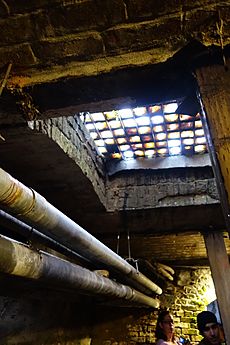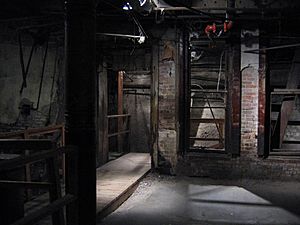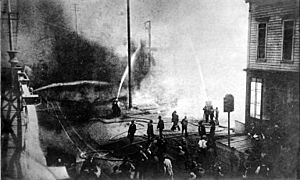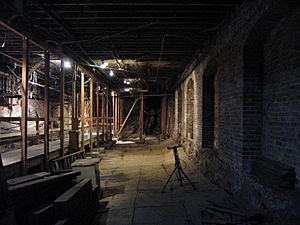Seattle Underground facts for kids
The Seattle Underground is a fascinating network of old tunnels and basements. You can find them beneath the streets of the Pioneer Square area in Seattle, Washington. These areas were once the ground level of the city when it was first built in the mid-1800s. However, they became hidden and unused after the streets were raised. Today, these underground passages are a popular place for guided tours.
How Seattle Went Underground

On June 6, 1889, a big fire started in a carpentry shop. It was the worst fire in Seattle's history, destroying many buildings. After this Great Seattle Fire, the city decided to rebuild differently. New buildings had to be made of stone or brick, not wood. Also, the city decided to raise the streets.
Why raise the streets? The Pioneer Square area was built on soft, filled-in land near the water. It often flooded, especially during high tides. Raising the streets helped stop the flooding. It also made sure the sewers could drain properly into Elliott Bay without backing up.
To raise the streets, workers built concrete walls along the sides. This created narrow spaces between the new walls and the old buildings. Then, they used water to wash dirt and material into these spaces. This filled up the "alleys" and raised the streets. The new street level was often about 12 feet higher than before. In some spots, it was nearly 30 feet higher!
At first, people used ladders to go from the new street level down to the old sidewalks. Later, brick arches were built over the old sidewalks. Small glass blocks, called vault lights, were put into the new sidewalks above. These vault lights let sunlight shine down into the underground areas. This is how the Seattle Underground was formed.
When builders rebuilt their shops and homes, they knew the old ground floor would soon be underground. So, they put fancy decorations on the next floor up. This new floor became the main entrance for businesses.
Even after the new sidewalks were ready, some shop owners kept doing business on the lowest floors of buildings that survived the fire. People continued to use the underground sidewalks, which were lit by the vault lights above.
In 1907, the city closed off the underground areas for health and safety reasons. The basements were left empty or used for storage. Some parts became secret meeting places.
Underground Tours Today
Only a small part of the Seattle Underground has been fixed up and made safe for visitors. In 1965, a local person named Bill Speidel started "Bill Speidel's Underground Tour." This tour still runs today from the Pioneer Building. The tour takes you through old storefronts, shows you artifacts, and lets you see different tunnel entrances.
Another tour, called "Beneath the Streets," started in 2013. It explores other parts of the underground network.




